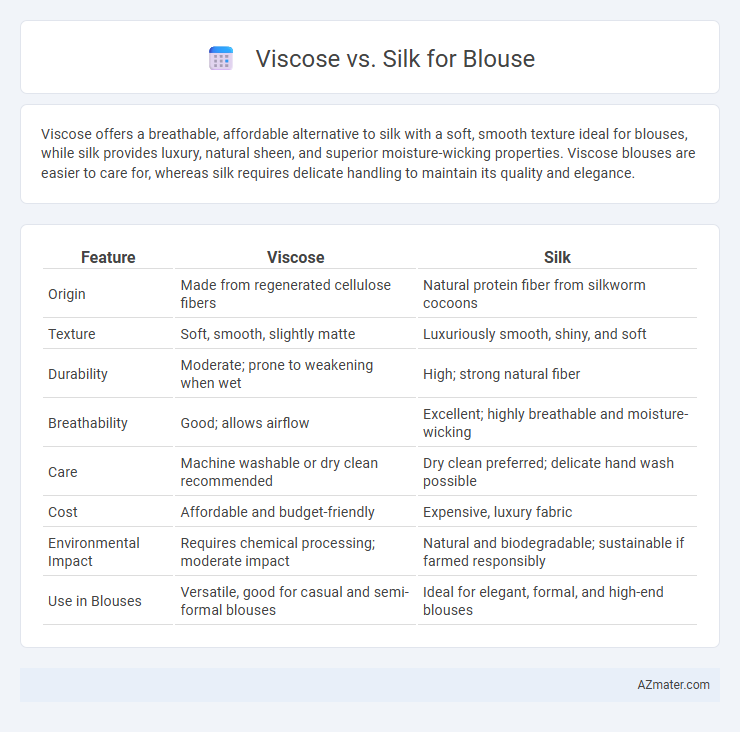Viscose offers a breathable, affordable alternative to silk with a soft, smooth texture ideal for blouses, while silk provides luxury, natural sheen, and superior moisture-wicking properties. Viscose blouses are easier to care for, whereas silk requires delicate handling to maintain its quality and elegance.
Table of Comparison
| Feature | Viscose | Silk |
|---|---|---|
| Origin | Made from regenerated cellulose fibers | Natural protein fiber from silkworm cocoons |
| Texture | Soft, smooth, slightly matte | Luxuriously smooth, shiny, and soft |
| Durability | Moderate; prone to weakening when wet | High; strong natural fiber |
| Breathability | Good; allows airflow | Excellent; highly breathable and moisture-wicking |
| Care | Machine washable or dry clean recommended | Dry clean preferred; delicate hand wash possible |
| Cost | Affordable and budget-friendly | Expensive, luxury fabric |
| Environmental Impact | Requires chemical processing; moderate impact | Natural and biodegradable; sustainable if farmed responsibly |
| Use in Blouses | Versatile, good for casual and semi-formal blouses | Ideal for elegant, formal, and high-end blouses |
Introduction to Viscose and Silk Fabrics
Viscose, a semi-synthetic fiber derived from natural cellulose, offers a lightweight, breathable, and cost-effective option for blouses, mimicking the softness and sheen of natural fabrics. Silk, a natural protein fiber produced by silkworms, remains prized for its luxurious texture, exceptional luster, and superior moisture-wicking properties, ideal for premium blouse designs. Both fabrics exhibit unique characteristics that influence comfort, drape, and maintenance, making the choice dependent on style preferences and fabric care considerations.
Origins and Production Methods
Viscose is a semi-synthetic fiber derived from cellulose extracted from wood pulp, primarily produced through a chemical process involving carbon disulfide and sodium hydroxide, while silk is a natural protein fiber obtained from the cocoons of silkworms through a delicate and labor-intensive harvesting and reeling process. The production of viscose involves dissolving cellulose and regenerating it into fiber form, enabling mass production at a lower cost and with variable textures. In contrast, silk's production is limited by the biological cycle of silkworms, making it a luxurious and more environmentally sensitive material.
Texture and Feel of Viscose vs Silk
Viscose blouse fabric features a soft, smooth texture that mimics the feel of natural fibers while offering excellent breathability and lightweight comfort. Silk, on the other hand, provides a luxurious, glossy texture with a natural sheen and a smooth, silky touch that feels cool against the skin. While silk delivers an elegant, fluid drape, viscose offers a slightly more matte finish with a comparable softness, making both fabrics desirable for sophisticated blouse designs.
Breathability and Comfort Comparison
Viscose and silk both offer unique benefits for blouse fabric, with breathability and comfort as key differentiators. Viscose, made from regenerated cellulose fibers, provides excellent breathability and moisture absorption, making it ideal for warm weather and prolonged wear. Silk, a natural protein fiber, excels in softness and temperature regulation, offering luxurious comfort but with lower moisture-wicking capacity compared to viscose.
Durability and Longevity
Viscose blouses offer moderate durability but tend to weaken with frequent washing and exposure to moisture, making them less ideal for long-term wear compared to silk. Silk blouses boast excellent strength and natural resilience, maintaining fabric integrity and sheen over time when properly cared for. Investing in silk ensures a blouse with superior longevity due to its high tensile strength and natural protein fibers that resist wear and tear.
Maintenance and Care Requirements
Viscose blouses require gentle hand washing or machine washing on a delicate cycle with cold water to prevent shrinking and maintain fabric softness, while silk blouses demand even more careful handling through dry cleaning or hand washing with mild detergent to preserve their natural sheen and delicate fibers. Avoiding high heat drying is crucial for both fabrics; viscose tends to wrinkle easily and benefits from air drying flat, whereas silk should be dried away from direct sunlight to prevent fabric damage and color fading. Proper storage in a cool, dry place and avoiding exposure to harsh chemicals or bleach ensures longevity for both viscose and silk blouses, with silk necessitating added precautions due to its luxurious and sensitive composition.
Price Difference and Affordability
Viscose blouses are significantly more affordable than silk, with prices often ranging from $15 to $50 compared to silk blouses that typically cost between $70 and $200 or more. The lower cost of viscose stems from its semi-synthetic production process and ease of mass manufacturing, making it accessible for budget-conscious shoppers. Silk, known for its natural fibers and luxurious feel, remains a premium choice that commands higher prices due to its labor-intensive harvesting and fabrication.
Environmental Impact and Sustainability
Viscose production involves extensive chemical processing and deforestation, contributing to significant environmental degradation and high water consumption. Silk, while natural and biodegradable, requires large amounts of mulberry leaves and energy-intensive farming of silkworms, raising concerns about resource use and ethical considerations. Choosing organic viscose or peace silk can mitigate some sustainability issues, but both fabrics have distinct environmental trade-offs to consider for eco-conscious blouse manufacturing.
Fashion Versatility and Style
Viscose offers excellent fashion versatility for blouses due to its lightweight, breathable fabric that drapes well and accommodates vibrant prints and colors, making it ideal for casual and office wear. Silk provides unparalleled elegance and a luxurious sheen, perfect for formal occasions and evening events, lending a sophisticated and timeless style. Both fabrics enhance blouse designs, but viscose emphasizes comfort and everyday wearability, while silk highlights refinement and high-end fashion appeal.
Choosing the Right Fabric for Your Blouse
Viscose offers a lightweight, breathable option with a smooth texture that mimics silk at a more affordable price, making it ideal for everyday blouses. Silk provides a natural sheen, excellent moisture-wicking properties, and a luxurious feel perfect for special occasions or elegant designs. Consider the blouse's intended use, care requirements, and budget when choosing between viscose and silk fabrics to ensure comfort and style.

Infographic: Viscose vs Silk for Blouse
 azmater.com
azmater.com